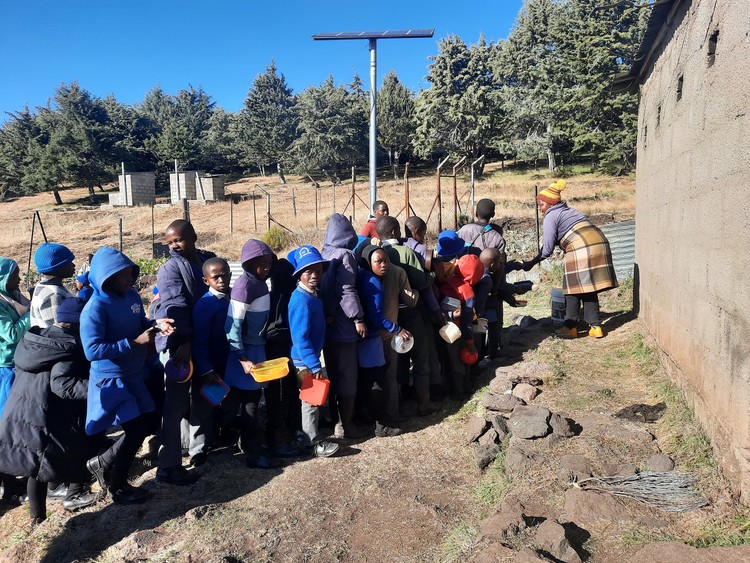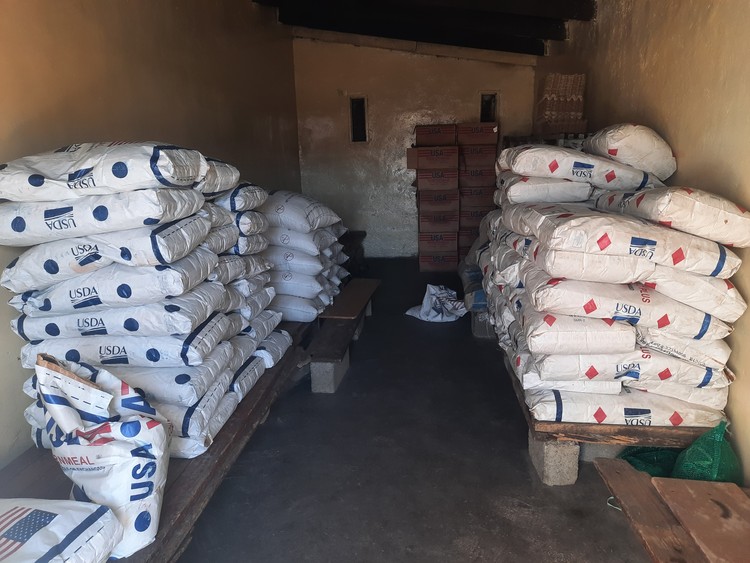US cuts food aid to 36,000 children in Lesotho
About one in five people in rural Lesotho face food insecurity
Learners at Ha Samuel Primary School queue for their breakfast. Photos: Sechaba Mokhethi
- A programme designed to feed more than 36,000 learners at 200 schools in Lesotho will now end after abrupt cuts by the US Department of Agriculture.
- The Lesotho government says it’s own food programme will now cover these schools. But the government’s food programme does not have a good track record.
- Dozens of small-scale farmers who expanded their production to supply the US-funded programme are facing big losses.
It is 8:23am in the highlands of Semonkong. Learners line up at Ha Samuel Primary School for their morning porridge. Many of them would not have had breakfast were it not for the school’s food scheme.
Over 20% of the Lesotho population is at risk of not having enough food. Rates of childhood stunting due to malnutrition are high. Many children are from child-headed households. “For some of them, lunch at school is the last meal of the day,” said one teacher.
Ha Samuel is among 200 schools fed by Bokamoso Ba Bana, a programme funded for $28.5-million (M511.2-million) over five years by the United States Department of Agriculture (USDA). (One loti (M) is equal to one South African Rand.)
Run by Catholic Relief Services (CRS), a US-based humanitarian organisation, the programme was designed to support more than 36,000 children from 2022 until 2027. Minister of Education Ntoi Rapapa has estimated that the project feeds 17% of primary school learners in Lesotho.
But GroundUp has learned that the USDA has abruptly cut its funding of the programme. CRS issued a global announcement (removed from their website following GroundUp questions, but still on the Internet Archive) on 21 May that more than 780,000 children in 11 countries will be affected by the cuts to their food programmes.
But schools in Lesotho say they have not been formally told the programme will end. We spoke to seven teachers at three schools — Ha Samuel, St Leonard Primary School in Semonkong, and Senqu Anglican in Mokhotlong. They had heard rumours that the programme might end, but no official confirmation.
One of the cooks at Ha Samuel Primary School, Mantina Mojakhomo, cooking beans for lunch.
Matlhokomelo Liporo, who manages feeding at Ha Samuel, said she was told by a CRS staff member that “they might not come back after winter break because of President Trump’s aid cuts”.
A teacher at St Leonard Primary, Mojapela Ramothibe, said the school’s 630 students relied heavily on these meals. “Now they are full, attentive, and participate more in class without worrying about hunger,” he said. “CRS never lets the storerooms run dry.”
His colleague, ‘Mampho Ntlhanngoe, noted that CRS also trained schools to grow their own vegetables and provided seeds to the school. “We improved on self-reliance,” she said. But other foodstuffs that they cannot grow are still needed.
CRS Country Representative Kris Ozar confirmed that the programme will end, but said they are “still trying to understand the implications and next steps” and are working to communicate with their partners.
The cuts to the food programme are among a raft of drastic measures taken by the US government in recent months, decimating Lesotho’s health sector, particularly the HIV response. Last week, a US Congressional delegation led by Katherine Bowles from the Senate Appropriations Committee visited the country to assess the broader impact of American aid in the country and “inform decisions by the US Senate”.
The storeroom at St Leonard with maize meal donated by USDA. Donations from USDA will now stop.
More than just meals
Beyond providing meals, CRS also partnered with the Lesotho College of Education to offer 25 annual scholarships between 2024 and 2026 to preschool teachers from the targeted districts to study for Early Childhood Education certificates at the college.
The project also aimed to invest in the local economy. Over its five-year lifecycle, it would procure 3,050 tonnes of food including beans, leafy greens, and eggs from regional and local farmers, in addition to the 6,950 tonnes of US-donated staples like maize meal.
School infrastructure was also improved under the project. Ha Samuel previously had no toilets, forcing students and teachers to use the surrounding bushes. But CRS built proper sanitation facilities and provided sanitary pads, enabling girls to attend school during their periods.
“They even trained boys about menstruation,” Liporo said. “Now, a boy will come asking for a pad to help a classmate whose dress got blotted. That confidence and empathy didn’t exist before.”
With the programme now cut, teachers worry they will have to rely once again on the under-resourced and poorly managed government feeding scheme.
“We will go back to our old problems,” said ‘Mammenyane Thatho of St Leonard. “Many kids come to school hungry, expecting their first meal here.”
‘Mabafokeng Mothibi, in Semonkong, who works with a cooperative of other farmers to supply 46 schools in the area, said the programme’s termination spells disaster for local farmers. “Almost every vegetable farmer here was involved in the project supply chain,” she said.
She says she helped resource-poor farmers in the area with seedlings and would later split sales revenue with them. From other farmers she would buy vegetables at M10 per kilogram.
In total, Mothibi and her colleagues supplied almost a tonne of green vegetables to different schools every month.
“Many farmers expanded production in anticipation of supplying schools under the CRS project. Now they will be stuck with unsold crops on their fields if the project does not continue,” she said.
Cooks are also worried about their livelihoods. Under CRS, cooks earned about M3,200 per month, more than double the M1,500 they were paid under the government feeding programme in the past.
Toilets built at Ha Samuel Primary by the US-funded CRS programme.
Government assures continuity
Lesotho’s Principal Secretary for Education Ratšiu Majara insists the government can absorb the loss and continue with the programme.
“We are aware of the termination,” he told GroundUp. “But the school feeding programme existed before, and I guarantee that children in Semonkong, Thaba-Tseka, and Mokhotlong will continue to get their meals.”
The government allocates about M240-million annually for school feeding and receives additional support from the World Food Programme (WFP). In 2024, WFP received €600,000 (M11,936.486) from Monaco and about M25-million from Japan to boost Lesotho’s school feeding programme.
But teachers and feeding managers at primary schools are sceptical. They say that when they were previously under the government programme, they frequently ran out of food.
“Attendance would drop,” Ramothibe recalled. “Some kids only came to school to eat.”
Liporo said many children walked for up to two hours to get to school at Ha Samuel on an empty stomach, only to find no food upon arrival.
Support independent journalism
Donate using Payfast

Don't miss out on the latest news
We respect your privacy, and promise we won't spam you.
Next: Blind SA takes schools to court over conditions for children with disabilities
Previous: Pensioner has to live in shack despite ‘owning’ RDP house for 17 years
© 2025 GroundUp. This article is licensed under a Creative Commons Attribution-NoDerivatives 4.0 International License.
You may republish this article, so long as you credit the authors and GroundUp, and do not change the text. Please include a link back to the original article.
We put an invisible pixel in the article so that we can count traffic to republishers. All analytics tools are solely on our servers. We do not give our logs to any third party. Logs are deleted after two weeks. We do not use any IP address identifying information except to count regional traffic. We are solely interested in counting hits, not tracking users. If you republish, please do not delete the invisible pixel.




